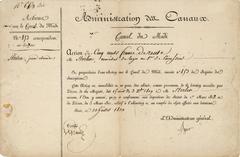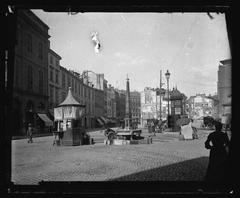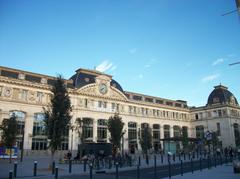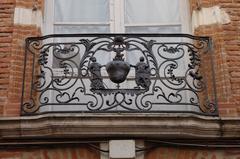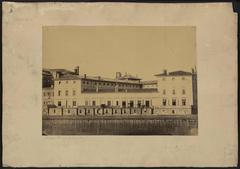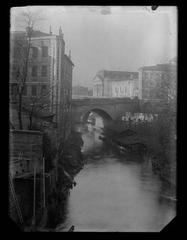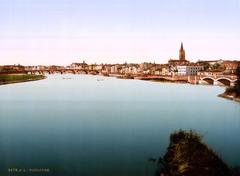
Bayard Lock Toulouse: Visiting Hours, Tickets, and Historical Sites Guide
Date: 04/07/2025
Introduction
Nestled in the dynamic city of Toulouse, France, Bayard Lock (Écluse Bayard) is a remarkable relic of engineering history, standing as one of the largest and earliest locks on the legendary Canal du Midi. Since 1996, the Canal du Midi has been recognized as a UNESCO World Heritage Site, and Bayard Lock offers visitors an evocative window into the technical brilliance and cultural legacy that shaped Southern France’s waterways. Constructed around 1670 and located near the bustling Gare de Toulouse-Matabiau, this double lock not only navigates the canal’s elevation changes but also anchors a vibrant area where history, engineering, and urban life converge (barefootblogger.com; toulouse-tourisme.com).
The Canal du Midi itself, masterminded by Pierre-Paul Riquet in the 17th century, was an ambitious project linking the Garonne River in Toulouse with the Mediterranean Sea. It revolutionized trade and transportation, introducing innovative lock designs—most notably the ovoid chambers that imparted unique structural stability to its locks (britannica.com; en.wikipedia.org). Today, Bayard Lock is a living monument, offering immersive experiences through its stonework, operational mechanics, and picturesque towpaths, all freely accessible year-round. This guide provides comprehensive details on visiting hours, ticketing, accessibility, nearby attractions, and practical tips to enrich your visit to this iconic landmark.
Contents
- Historical Development of the Canal du Midi
- Engineering Innovations and Lock Design
- The Bayard Lock: Historical Context and Role
- Bayard Lock in Toulouse’s Urban and Cultural Life
- Practical Visitor Information
- Visiting Hours
- Tickets and Fees
- Accessibility
- Guided Tours and Events
- Things to Do Near Bayard Lock
- Dining and Accommodation
- Tips for a Memorable Visit
- Frequently Asked Questions (FAQ)
- Conclusion and Planning Your Visit
- Visual Resources & Internal Links
- References
Historical Development of the Canal du Midi
The Canal du Midi, spanning 240 kilometers across Southern France, is celebrated as one of the crowning achievements of 17th-century civil engineering. Conceived by Pierre-Paul Riquet and built between 1666 and 1681 under the reign of Louis XIV, its primary aim was to create a direct, safe trade route between Toulouse and the Mediterranean, bypassing the lengthy and hazardous Strait of Gibraltar (britanica.com; thegoodlifefrance.com). The canal’s inauguration in 1681 marked a new era for inland navigation and commerce, and it remains operational today, earning UNESCO World Heritage status in 1996 (canaldumidi.com; fortravelovers.com).
Engineering Innovations and the Role of Locks
Managing elevation changes was one of the most formidable challenges in the canal’s construction. The Canal du Midi rises 63 meters over 51.5 kilometers from Toulouse to its summit, then descends 189 meters to the Mediterranean (britannica.com). To facilitate this, 91 locks were built along the main course, each employing Riquet’s innovative ovoid chamber design for superior structural integrity (en.wikipedia.org). The locks, constructed with stone, lime, and robust timber gates, remain iconic features of the canal’s enduring Baroque infrastructure (en.wikipedia.org).
The Bayard Lock: Historical Context and Construction
Bayard Lock is one of the earliest and most substantial locks on the Canal du Midi, sited in Toulouse’s Matabiau district, just across from the main train station (plan-canal-du-midi.com). Built around 1670, it is the third lock encountered as vessels travel from the city center toward the Mediterranean (canaldumidi.com). As a double lock, Bayard Lock uses two chambers in sequence, accommodating greater elevation changes and enabling efficient navigation from Toulouse toward the Lauragais plains (en.wikipedia.org). Its proximity to the city center and railway station cemented its importance in Toulouse’s urban development.
Bayard Lock’s Urban and Cultural Significance
Bayard Lock is more than a technical feat; it is a vital part of Toulouse’s identity. Its presence at the threshold between the urban core and tranquil canal embankments attracts both locals and tourists for walks, bike rides, and boat tours. The lock’s location near Gare Matabiau makes it a focal point for city exploration, and its ongoing function as an operational lock links historical heritage with modern urban life (plan-canal-du-midi.com; fortravelovers.com).
Practical Visitor Information
Visiting Hours
Bayard Lock is outdoors and open to the public year-round from dawn to dusk. There is no official entry gate or ticket booth.
Tickets and Fees
- Free Access: There is no entrance fee to visit Bayard Lock itself.
- Guided Tours and Cruises: Tickets are required for canal cruises or guided tours that include Bayard Lock. Book these through local operators or the Toulouse Tourist Office (bateaux-toulousains.com).
Accessibility
- Wheelchair Access: The lock and towpaths are generally wheelchair accessible, with paved paths and gentle slopes. Some sections may be uneven, so caution is advised.
- Public Transport: Directly across from Gare de Toulouse-Matabiau, with metro, bus, and taxi connections (toulouse-tourisme.com).
Guided Tours and Special Events
- Walking & Cycling Tours: Several local companies and the Toulouse Tourist Office offer tours featuring Bayard Lock and the Canal du Midi.
- Cultural Events: Seasonal festivities, boat parades, and art installations sometimes take place along the canal—check local listings for schedules.
Things to Do Near Bayard Lock
- Canal Walks & Cycling: The towpaths provide scenic routes for walking and biking, leading toward Ponts Jumeaux or into the countryside (fortravelovers.com).
- Boat Watching: Observe the lock in operation as boats are raised or lowered—a favorite activity for visitors of all ages.
- Explore Nearby Attractions: Walk to Place du Capitole, Basilica of Saint-Sernin, or Musée des Augustins to round out your city exploration (travelsetu.com).
Dining and Accommodation
- Dining: Canal-side cafés and restaurants, including barge-based venues like L’Oenotilus, are within easy reach (cntraveller.com).
- Accommodation: Choose from historic hotels such as the Grand Hôtel de l’Opéra or opt for modern convenience near Gare Matabiau (cntraveller.com).
Tips for a Memorable Visit
- Best Season: Spring and early autumn offer mild weather and lush canal scenery. Plane tree-lined banks are particularly picturesque, though some trees have been removed due to disease (barefootblogger.com).
- Photography: Early morning or late afternoon provides ideal lighting for photos of the lock and canal life.
- Events: Check for festivals or special events that may coincide with your visit.
Frequently Asked Questions (FAQ)
Q: What are the Bayard Lock visiting hours?
A: Open year-round during daylight hours, from dawn until dusk.
Q: Is there an entrance fee?
A: No, visiting Bayard Lock is free.
Q: Can I see the lock in operation?
A: Yes, the lock is active, with boats passing through regularly.
Q: Is Bayard Lock wheelchair accessible?
A: Yes, with mostly paved and flat paths, though some areas may be uneven.
Q: Are guided tours available?
A: Yes, through local operators and the tourist office.
Conclusion and Planning Your Visit
Bayard Lock is a captivating blend of historical grandeur, engineering ingenuity, and urban vitality. As a gateway to the Canal du Midi and a symbol of Toulouse’s rich heritage, it offers a rewarding experience whether you’re a history buff, architecture enthusiast, or simply seeking a scenic walk. With free entry, easy public transport access, and proximity to city landmarks, Bayard Lock is a must-see in Toulouse’s Pink City.
Plan your visit during spring or early autumn for the best atmosphere, and consider joining a guided tour or canal cruise for deeper insight. For the latest updates, download the Audiala app and consult local tourism resources.
Visual Resources & Internal Links
- Images: Feature photos of Bayard Lock’s double chambers, stonework, and boats in action.
- Map: Show Bayard Lock’s location in relation to Gare Matabiau and Toulouse’s city center.
- Related Articles:
References
- Canal du Midi history and Bayard Lock details (barefootblogger.com)
- Bayard Lock and Toulouse monuments (toulouse-tourisme.com)
- Canal du Midi overview (britannica.com)
- Canal du Midi locks (en.wikipedia.org)
- Bayard Lock visitor information (plan-canal-du-midi.com)
- Boat tour brochure and tickets (bateaux-toulousains.com)
- Toulouse tourist guide (touristplaces.guide)
- Toulouse travel planning (toulouse-tourisme.com)
- Audiala guided tours (audiala.com)


